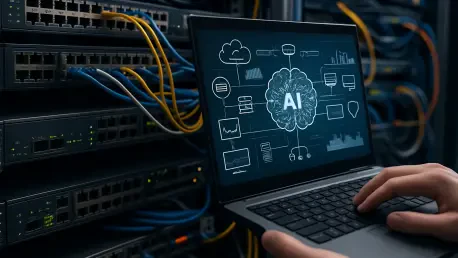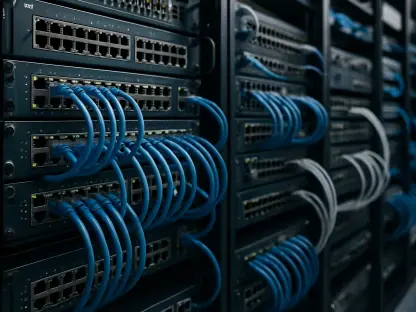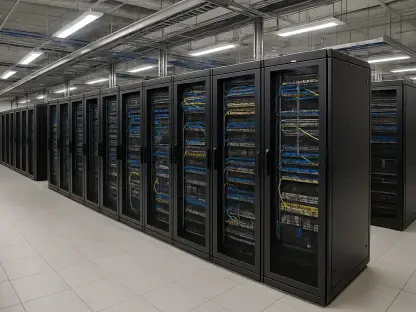Matilda Bailey has established herself as a prominent voice and innovator in the realm of networking, specifically focusing on cutting-edge technologies like cellular, wireless, and next-gen solutions. Today, we delve into the role artificial intelligence (AI) plays in transforming networks and infrastructures, dissecting the real-world impacts and advancements that are unfolding in this dynamic field.
Can you explain the two primary ways AI is transforming networking today?
AI in networking takes on two significant roles. Firstly, it serves as an intelligent assistant for network management, simplifying troubleshooting and automating routine tasks, which allows human engineers to focus on more complex issues. Secondly, AI shapes the infrastructure itself, ensuring it’s robust enough to support demanding AI workloads that require real-time data transfers with low latency and high reliability.
In what ways is AI assisting network management and troubleshooting?
AI-powered tools enhance network management by analyzing logs, identifying anomalies, and suggesting remediation steps. These systems analyze vast amounts of telemetry data and historical cases to offer insights and automate repetitive tasks, enabling quicker decision-making and problem-solving within network operations.
What are some specific examples of how AI-powered network assistants improve operations?
Network assistants improve operations by mapping dependencies and analyzing patterns over time. They are adept at identifying root causes and suggesting preventative measures, similar to a seasoned chef diagnosing cooking mishaps. These assistants provide strategic support, transforming complex network issues from mere symptoms to comprehensible solutions.
How do AI-powered systems help in mapping dependencies and analyzing patterns?
AI systems foster an understanding of network environments by connecting historical data and dependencies, which makes it easier to identify correlations and potential risks. This deep analysis aids in problem prediction, turning network troubleshooting into a methodical process rather than a guessing game.
What is unified observability, and why is it significant in the context of AI and networking?
Unified observability integrates performance monitoring, security analytics, and application observability, creating a holistic view of the network stack. It’s significant because it bridges the data gap, enabling teams to pinpoint issues faster and improve overall network health. With AI’s analytical power, it shifts from simple visibility to comprehensive understanding.
How does multi-domain observability differ from traditional visibility?
Multi-domain observability goes beyond traditional visibility by connecting insights across different network domains, thus enhancing understanding and reducing finger-pointing during troubleshooting. It transforms scattered data into aligned insights, facilitating smarter operational decisions across network environments.
What challenges does unified observability help address in troubleshooting network issues?
Unified observability mitigates the challenge of pinpointing the exact location of issues within a network. By providing interconnected insights, it minimizes disruptions caused by assumptions and helps teams to solve problems efficiently and accurately, reducing downtime and optimizing network performance.
How can AI be utilized in network infrastructure to support AI workloads?
AI can enhance network infrastructure by ensuring it has the necessary bandwidth, latency, and reliability to support AI workloads. This involves integrating AI optimization techniques into hardware and software, tailoring networks to accommodate the heavy data demands of AI applications.
Why is low latency and strict reliability crucial for AI workloads in networking?
AI workloads often involve real-time data processing, which necessitates swift and reliable data transfer. Low latency ensures fast responses while strict reliability guarantees consistent performance, both of which are crucial for maintaining the integrity and efficiency of AI-driven tasks and operations.
What advancements are being made in industrial and edge infrastructure to accommodate AI demands?
In industrial and edge environments, advancements such as heightened bandwidth, PoE capabilities, and time-sensitive networking are being implemented. These improvements are designed to support AI applications like vision systems and robotics by maintaining rigorous data transfer requirements and ensuring network stability.
Can you describe the role of PoE and PoE++ in supporting AI in industrial environments?
PoE and PoE++ provide direct power to smart devices like cameras and sensors integrated within industrial networks. This energy efficiency enables seamless AI operations without excess wiring, supporting complex environments where consistent power and connectivity are essential for real-time AI tasks.
How do time-sensitive networking and redundancy features contribute to AI applications?
Time-sensitive networking ensures that data related to safety-critical applications is delivered promptly, while redundancy features guarantee network reliability. Together, they prevent disruptions and maintain operational continuity, making them indispensable for AI applications that require precision and robustness.
What changes are necessary in campus and wireless networks to support next-generation AI workloads?
Campus and wireless networks need upgrades in connectivity and automation to accommodate next-gen AI workloads. Enhancements in bandwidth, resilience, and intelligent networking solutions are required to handle the increasing complexity and scale of AI-driven environments, ensuring swift and reliable performance.
Why is ultra-reliable wireless backhaul becoming important for AI applications?
Ultra-reliable wireless backhaul is crucial for maintaining connections in mobility-centric AI applications such as autonomous vehicles and drones. It ensures seamless data transfer and stability, which is vital for operations that rely on uninterrupted communication between moving devices.
How is wireless technology evolving to support industrial environments?
Wireless technology in industrial settings is advancing by offering robust backhaul solutions and enhanced connectivity options. These developments are crucial for supporting mobile devices and AI applications that require extensive connectivity and adaptability within complex operational landscapes.
In implementing AI in networking, what key questions should businesses consider?
Businesses should consider how AI will impact their network’s performance and if their current infrastructure can support their AI ambitions. They need to evaluate whether AI implementations align with their organizational goals and if additional investments are needed to future-proof their network and prevent bottlenecks.
What is the importance of aligning AI with organizational purpose?
Aligning AI with organizational purpose ensures that AI initiatives contribute meaningfully to the business’s objectives rather than being a superficial addition. It facilitates strategic growth by integrating AI into the core operations, enhancing productivity and innovations that drive the company forward.
How can businesses ensure their network infrastructure is future-proof and not a bottleneck?
Businesses can ensure their network remains future-proof by continuously assessing and upgrading its capacity and reliability to accommodate evolving technologies and AI workloads. Proactive measures like adopting scalable solutions and incorporating advanced network management practices are key in preventing bottlenecks.
What is your forecast for the future of AI in networking?
In the future, AI in networking will likely evolve into a foundational element, driving deeper integration with IoT and edge technologies. Networks will become more adaptive and intelligent, capable of self-healing and optimized routing by leveraging AI’s predictive capabilities, transforming the overall landscape of connectivity and operations across industries.









